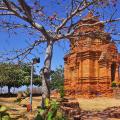Akkurum tract and its stone mushrooms - amazing place, which is located on the river (its right bank) at its confluence with the Chulcha river. In translation Akkurum means "White talus". This name is given to the accumulation of large blocks of hard rock, which are formed under the influence of the wind on the slopes or at their feet. The main feature of "kurums" is their ability to move slowly down the slope.
Panoramic view of the Chulyshman river valley from the side stone mushrooms (click on the picture to enlarge)
Kurums in the Karasu gorge are represented by boulders with unusual relief forms. Such forms are formed as a result of weathering and water erosion of individual rocks.
Stone mushrooms were formed in the gorge from blocks of solid rocks, which now represent a kind of umbrella for future creation. Over the years, the softer rocks of the stone eroded under the influence of precipitation, forming a "stem" of the fungus, which was constantly growing. Thus, a "company" of stone mushrooms was formed, which reliably hid in the Karasu gorge. 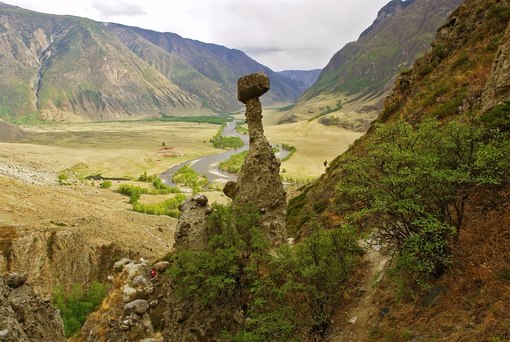
The majestic mushrooms are clearly visible from the bank of the Chulyshman River. But getting to them is not so easy. To do this, you need to overcome the path through the river itself, and choose the road in the direction of the Akkurum tract. In 30 minutes you can reach the foot of the mountains. 
The valley of stone mushrooms and the so-called shores of the Tract are mostly steep, and therefore one should move along them with extreme caution. But when you get to the stone mushrooms, you can admire not only an amazing creation of nature, but also a magnificent panorama overlooking the Chulyshman River, namely its valley.
In the Karasu gorge, there are two huge "mushrooms": "adult" and "young" mushrooms. The former reach a height of 5 meters, the latter are content with 1 - 2 meters. If you touch the stem of such mushrooms, you can feel the roughness of the surface. Small pebbles protrude along its entire perimeter. The mushroom cap is impressive and smoother to the touch.
An amazing feature of the Akkurum tract - the famous stone mushrooms continue to grow at the present time. This is due to the characteristics of the soil on which they are located. It consists of clay and gravel, which provide little movement of the mushrooms and their slow "growth". 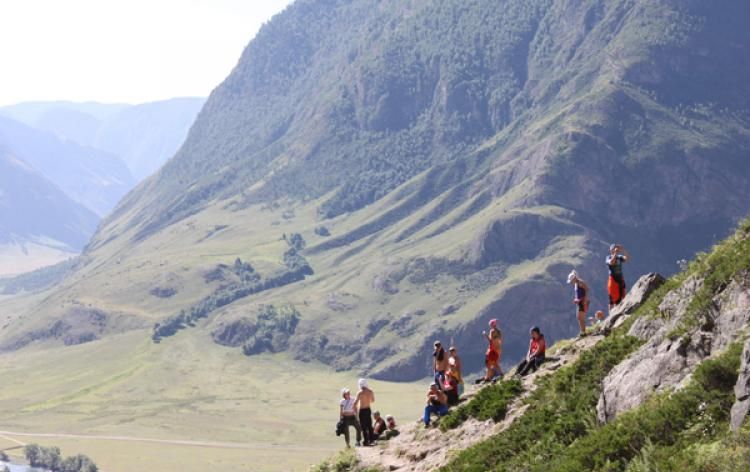
When you look at the stone mushrooms, it seems that their caps are about to fall. Mountain slopes are prone to minor earthquakes that can damage the mushrooms by shifting their caps. In 2003, there were a couple of small earthquakes that killed several mushroom caps.
Have local population there is a belief: when the last cap falls from the stone mushrooms or the mushrooms themselves collapse, the end of the world will begin.
What is the Akkurum Tract
Akkurum tract - beautiful place, popular with travelers and fans active rest... But so far it is not burdened with tourists and a large influx of pilgrims. That is why it preserves its original beauty and allows stone mushrooms to stand firmly on their feet. 
Akkurum tract is one of the ten amazing natural places Russia. The beauty of the river valley and mountain landscapes enchants visiting guests. The phenomenal stone mushrooms are protected. In 1960, the Sotera Valley was declared a state natural monument, and in 1980 it acquired the status of a nature reserve.
Viacheslav Smilyk / wikimedia.org kdmitr68 / fotki.yandex.ru kessler / altai-photo.ru asya / altai-photo.ru Natalyy2006 / altai-photo.ru Ivanov Sergey / wikimedia.org
Where the channels of two rivers, Chulyshman and Chulchi, merge, in Altai there is the Akkurum tract, the famous feature of which is Stone mushrooms. "White talus", as its name is often found in translation, is a unique pristine place where gigantic blocks have accumulated from solid rocks.
They, possessing a bizarre relief of forms, were formed at the foot of the slopes under the influence of age-old winds and water erosion. The uniqueness of the so-called kurums is that they are able to move down to the river, slowly sliding down the slope.
These stone formations are located directly in the river valley near the mouth of the Chulyshman. The area where the river flows into Lake Teletskoye rises against the backdrop of dense forests, rich in a variety of flora and fauna, can be seen among the open meadows. And somewhere in the distance, a blue ribbon of the fast-flowing waters of Chulyshman sparkles, over which seagulls constantly fly, looking for fish prey.
It is here in Altai that excursions are often conducted, walking along many winding paths, enjoying the wonderful floral aromas and the fragrant smell of local herbs.
The height of the Stone Mushrooms reaches 7 meters
The name "Stone mushrooms" came to these blocks from the people. Mysterious statues are simply gigantic in size: some of them reach amazing heights of about 7 meters, while the thickness of the "mushroom leg" is relatively small and no more than half a meter in diameter. Above, on each giant mushroom, a bulky growth of moss has formed.
All this creates a wonderful landscape picture against the background of the gorgeous landscapes of Altai, causing only positive emotions and a sense of surprise. After all, the creation of such a natural miracle seems absolutely unreal. How do Stone Mushrooms manage to stand motionless for so many hundreds of years?
How did such "mushrooms" appear?
Stone mushrooms, formed in the Karasu gorge from huge pieces of rock, in this moment represent a real umbrella, which can be safely called the basis, the canvas for subsequent creations.
 Stone mushrooms in Gorny Altai (asya / altai-photo.ru)
Stone mushrooms in Gorny Altai (asya / altai-photo.ru) Over the centuries, relatively fragile stones softened under the force of wind and precipitation, transforming into an ever-growing mushroom "stem". This is how a large mushroom cluster was formed, which took refuge in the Karasu gorge. From the coast of Chulyshman there is a great opportunity to observe these Stone mushrooms.
In addition, the Akkurum tract attracts more than one travelers or tourists. Similar natural phenomenon scientists also became interested. Geographers and geologists, trying to find out the nature of the origin of such a phenomenon as Stone mushrooms, spent a lot modern research in this domain.
As a result, it became known that such statues appeared in the process of prolonged washing out of rocks of different hardness. It was the breeds that were distinguished by superhardness and strength that acquired the flirtatiousness of mushroom caps. Over time, they sharpened, acquiring the same unique shape, which you can contemplate today.

Unlike cap rocks, stone mushrooms have legs, which are a looser structure. Due to the lower density level, they more intensively succumbed to deforming action. climatic conditions and time, which influenced their subtlety.
The surface of the mushroom leg has a roughness due to the appearance of small pebbles along the entire perimeter, which can be felt by stroking it. In turn, the tops of the mushrooms have a relatively gigantic, and has a smooth surface to the touch.
Features of stone sights
Tour of indicated places in Altai, it usually affects the places of both "stone myceliums". The fact is that Stone mushrooms can be conditionally divided into more mature and young statues. The latter are limited to more modest dimensions and very often are no more than two meters in height. Older blocks reach the largest sizes from five to seven meters.
However, Stone mushrooms, or rather some of them, decay over time, turn into dust and disappear. Meanwhile, in place of the dried up blocks, new ones still appear. Their growth is similar to the appearance of real mushrooms on the forest edge, but scientists cannot only guess the secret of their appearance today.
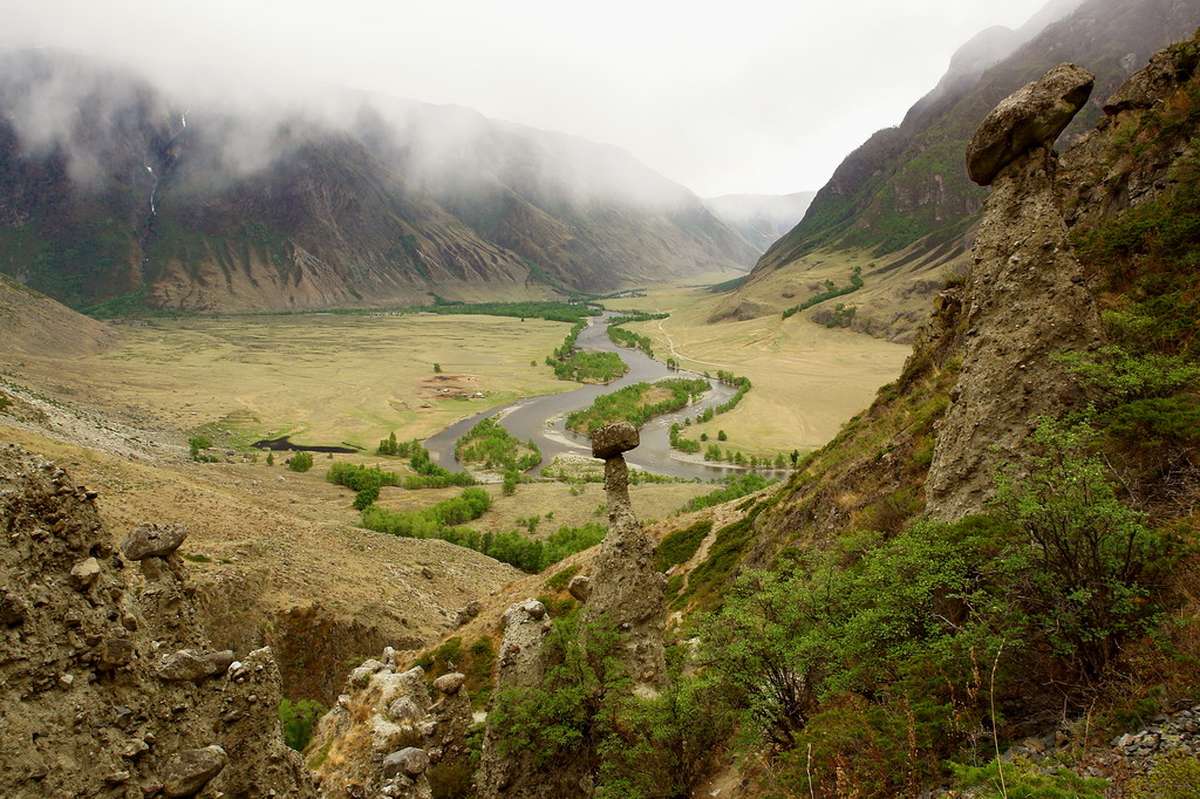 View of the Akkurum tract (Natalyy2006 / altai-photo.ru)
View of the Akkurum tract (Natalyy2006 / altai-photo.ru) Although some hypotheses of their unusual growth lend themselves to quite common explanations. Among the arguments, the most weighty can be considered the characteristics of the soil on which they are located. The soil, containing rubble and clay, affects the statues, allowing them little movement. If you look at the Stone Mushrooms from the river bank, you get the impression that the caps will slip off soon.
In mountainous areas, small earthquakes periodically occur, after which the tops shift. For example, about 10 years ago, recent earthquakes contributed to the fall of several caps.
Excursion to the Stone Mushrooms in the Akkurum Tract
In modern Altai, an excursion around the Akkurum tract is considered a fairly popular route. Guides and guides know about many stories from the folklore of local peoples, about legends that are breathtaking.
The most popular belief, which is introduced to tourists on excursions, is the assumption that tells about the beginning of the end of the world. This will happen when the last stone giant collapses or the last mushroom cap collapses from above.
Road to Stone Mushrooms
Getting to this attraction is somewhat difficult. The hard way to the famous "mushrooms" begins in the village of Aktash and continues to the very Chuysky tract. The biggest difficulty is crossing the river, then you need to overcome the Uchar waterfall.
Finding yourself on the opposite bank, it is important to choose the right direction of the path to the Akkurum tract. In addition, you can find yourself at the foot of the mountains in just half an hour. It is important not to forget about caution when moving along the steep banks of the Akkurum.
All problems on the way, difficulties and fears are more than compensated for by the pleasure and enjoyment of the natural stone creation, the panoramic panoramic panorama of the Chulyshman river valley.
Picturesque corner of Altai
Fans of outdoor activities and travelers with vast experience in their hobby behind their shoulders have always visited the Akkurum tract. This amazing place, filled with antiquity and vibrant energy of the river valley, is popular and famous. However, while this picturesque corner in Altai is not affected by the non-stop flow of tourists, it manages to preserve its primeval charm and be one of the first unique attractions in Russia.
All visitors are mesmerized by the beauty mountain ranges and the naturalness of the river valley. About fifty years ago, this valley acquired the status of a natural monument of nature, protected by the state. And twenty years later, Akkurum acquired its modern status - a reserved tract.
This river, starting from the high-mountainous lake Dzhulukul near the Tuvan border, cuts its way through 3-kilometer ridges, dividing the Ulagan plateau and the Chulyshman highlands; the height of the slopes of the valley in some places exceeds a kilometer.
On eastern part Inner Altai receives relatively little precipitation - between the local mountains and the endless plains lying in the north-west lie high mountain ranges, including the Katunsky ridge with Belukha Mountain. At the same time, it is relatively high here, and therefore cool; and not as dry as in the intermontane basins of Tuva or the Kosh-Agach region in the south of Altai.
7. 
There are fewer forests here than in Outer Altai, but there are trees; at the beginning of August it was cool, fresh and not cold in the mountains.
8. 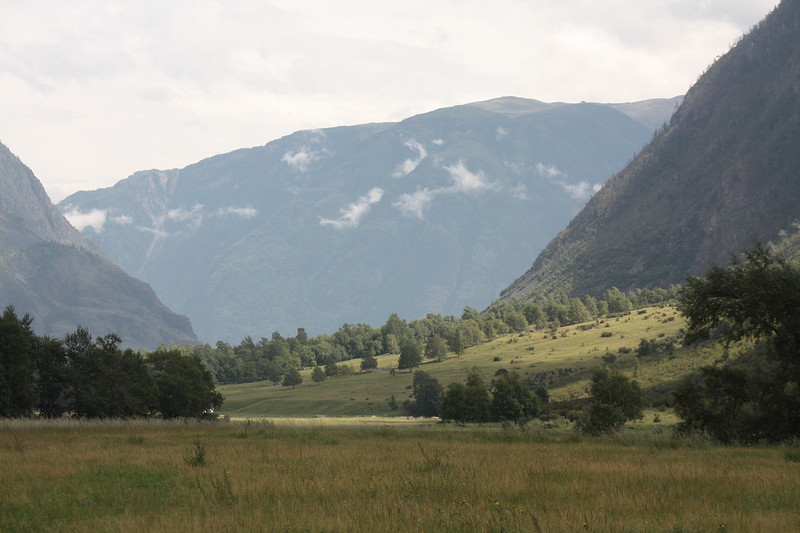
9. ![]()
When I was talking about, I mentioned that the mysterious Altai mountains (in principle, this is also true for the Sayan Mountains, but to a lesser extent) have always attracted those seeking enlightenment - from Baptists and Anastasievites to single freaks and madmen of all stripes; among the general mass, of course, there are also people who have really found something, who can be called the banal word "spiritualized". Gorny Altai - this is, after all, on a significant part of its territory, just low wooded ridges, not striking either in their size or beauty, the distances are completely Siberian; this is not where glaciers, kilometer-long rocks and beauty in general begin at a distance of several tens of kilometers from the plain, in Altai the distances are quite Siberian, and the real height begins far in the depths of the mountains. This primarily applies to; however, even there you can feel some special energy, that everything is not so simple in these mountains.
10. 
11. 
Here it is necessary to clarify that, in principle, I am not inclined to excessive romanticization and "animate" the surrounding area and nature.
12. 
And here, in the Chulyshman valley, this feeling of something special, a secret behind the visible, becomes much stronger - these are higher mountains, and desertedness, and a strange, slightly southern nature.
13. 
14. 
15. 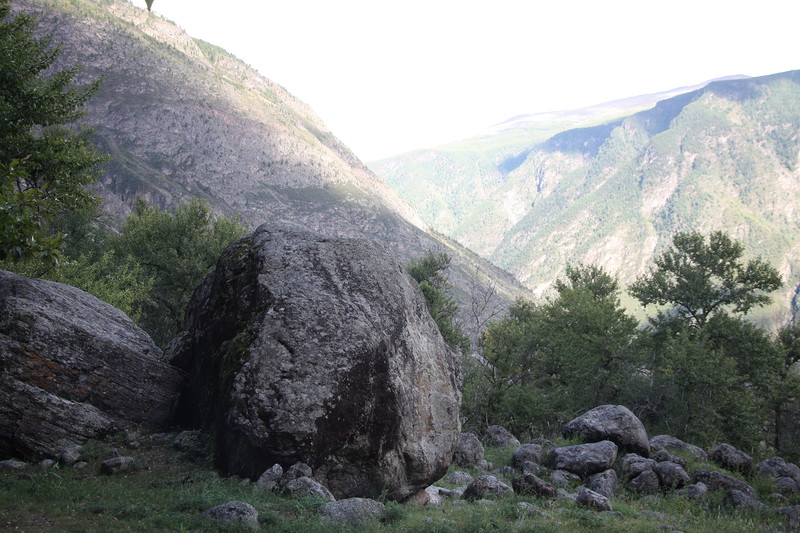
There is also this river, mountainous, but unexpectedly calm, with an even flow - you can even swim.
16. 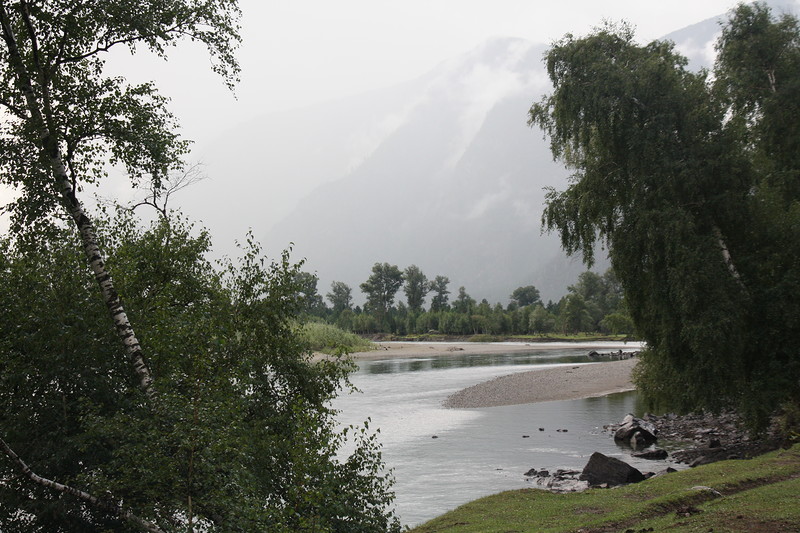
17. 
On my visit, it was also a constantly stopping and beginning rain, which created completely unrealistic lighting.
18. 
19. 
Immediately we must remember the Old Believers and the Roerichs who were looking for the promised land in the Uimon valley - there is also a lot of mystery and something hidden, probably even more than in the Chulyshman valley; this is the Western Altai, and more on that in a few more posts.
The Chulyshman stone mushrooms, one of the largest massifs of such formations in the world, do not diminish the mystery.
20. 
But first things first.
Ulagan region begins in the southern part of Lake Teletskoye - the most Altai region in terms of population (77% local residents - southern Altaians, including telengits).
He is also the most unsafe - both according to statistics and according to my personal feelings. Not only poverty affects, but also remoteness from cities and the "mainland" in general - in the words of one Russian Altaian, "the Soviet power never reached here." The politically incorrect ethnic factor (the mentality of the highlanders, the Mongoloids' weakness for alcohol) should not be underestimated either.
They say that not so long ago, local men went out to tourist groups with hunting rifles (which almost everyone has here), and collected tribute; if tourists were not there or there were few of them, or the mountaineers were especially wild, then they simply took everything they could and what they liked (including women). V last years However, under the influence of the growth of tourist traffic, many locals realized that by arranging tourist centers and taking tourists to them, you can cut down much more money than robbing tourists, scaring away potential visitors to these places.
21. 
It has become safer, in general. These stories were told to me by the guides - they were the only ones who picked us up in the mountains of Eastern Altai, where the locals will almost always give us a lift only for money. Another sharp region with the Caucasus, an almost stereotypical mountainous region.
Although Ulagan region is not yet very touristy (there are few tourists), already now a significant part of the local economy is associated with tourism, and locals perceive tourists, if not as unwanted outsiders, then at least as a source of money. And, as elsewhere in Gorny Altai, the tourist flow in the Chulyshman Valley is growing at an outstripping pace.
22. 
At the same time, in my experience, in tourist places in Russia and post-Soviet countries (Caucasian Mineral Waters, Sochi, Abkhazia, the Baltic States), they are more likely to be brought up than the national average - both tourists / summer residents and locals, often employed in the tourist business.
In general, I found travel companions in a very timely manner.
23. 
For those who missed the previous one: on a boat across Lake Teletskoye, I met a couple of Israelis with whom I was on the way at least a day ahead; and in the end we drove together for almost a week, until Belukha.
In the morning the weather was about the same as yesterday - the rain periodically resumed, and in between the clouds were strangely dragging up the mountain slopes and valleys.
24. 
The Chulyshman River was discovered very close to our makeshift camp.
25. 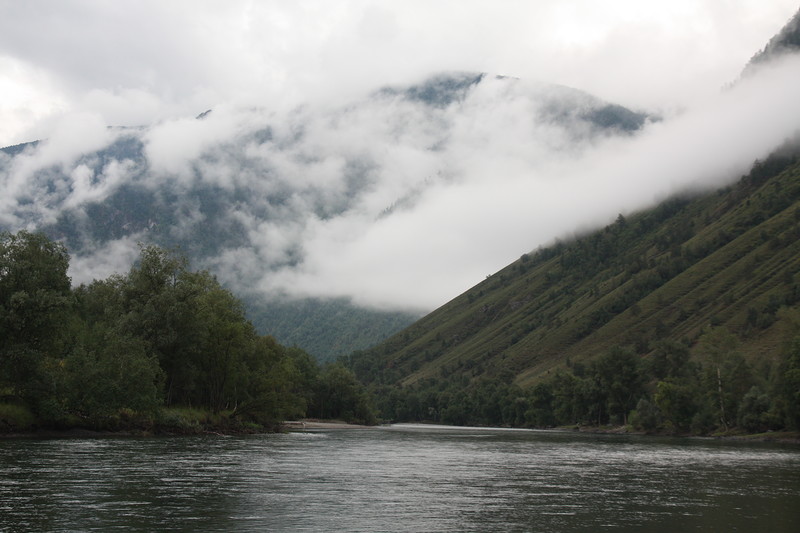
And local fishermen sleeping in an old gray "loaf".
26. 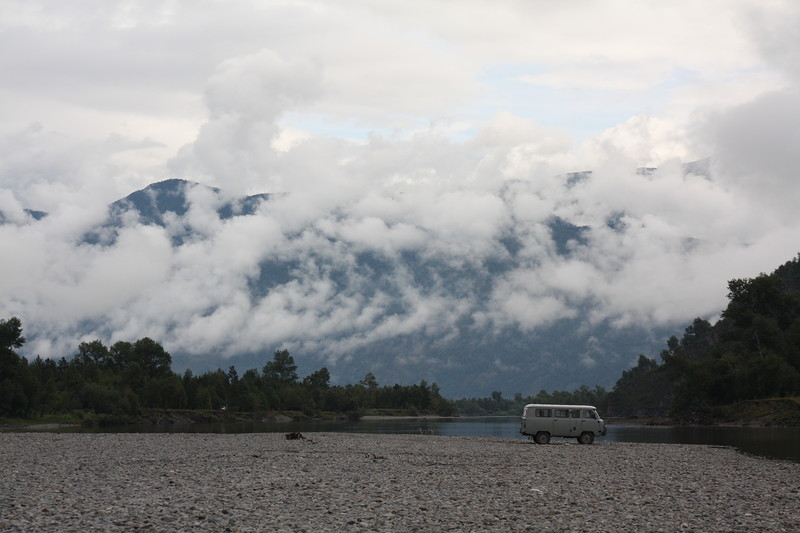
My comrades were originally going to walk almost all the way to the Chuisky tract - this is nearly 200 kilometers.
27. 
But I persuaded them to try hitchhiking - the road through the valley is beautiful, but long, and the villages can be unsafe; so we ended up in the car of the guide Yura. He was returning from a transfer of tourists somewhere in the mountains near south coast Teletsky coast; he told a significant part of the stories from the life of the locals and their interactions with tourists.
In Yura's car, like all the guides who drove us in these parts, firearms.
As is usually the case in the mountains, besides tourists, the main source of income for locals is cattle breeding.
28. 
Of course, hunting in the mountain taiga is also of great importance.
However, from the wild animals in the valley we met only the following:
29. 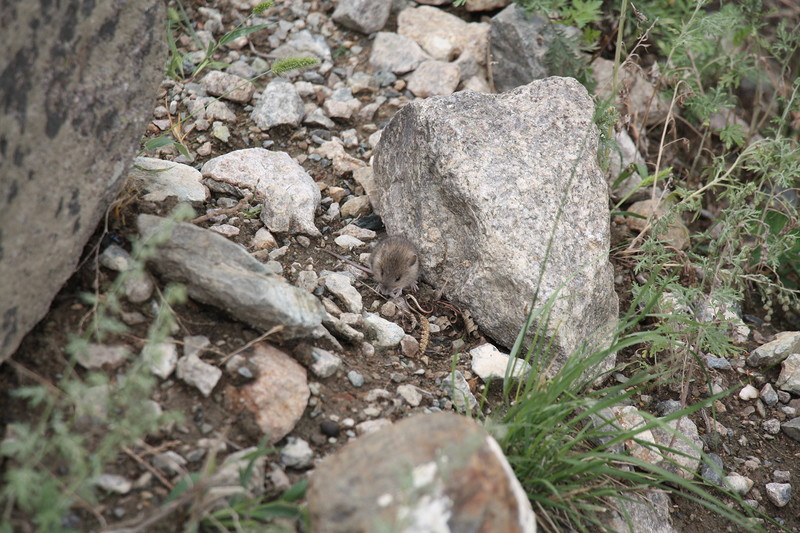
Horses here do not occupy the same position as in the steppes of Kazakhstan, but still there are much more of them here than in the Caucasus or in the mountains of Central and Western Europe.
30. 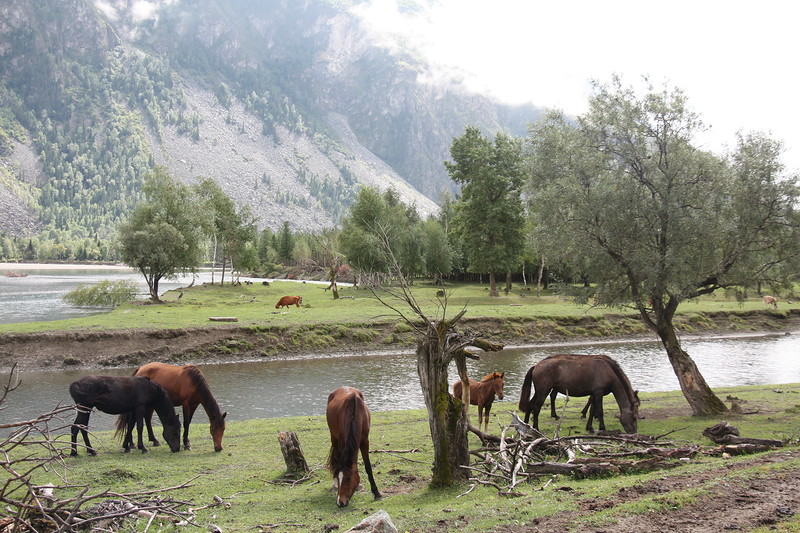
There are fewer cows, but they are also striking.
31. 
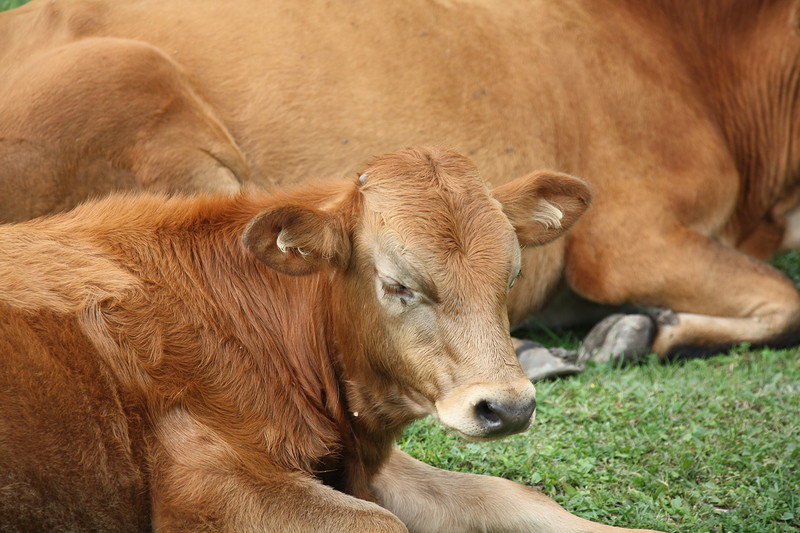
Two local species of cattle are picturesquely adjacent - I have never seen anything like this, it seems.
32. 
33. 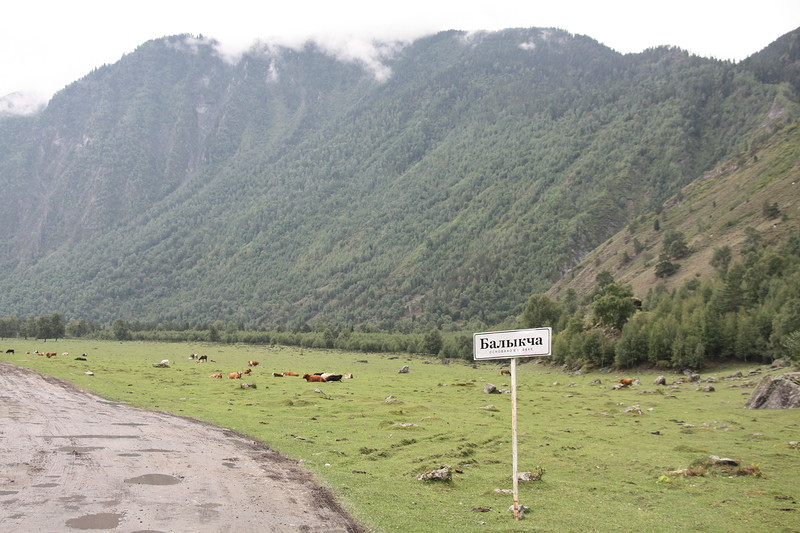
The village of Balykcha, closest to the lake - here we went to eat, but in the local store / cafe there were only hot belyashi with cheap oil, suspiciously similar to what people in Moscow love (loved) to sell at train stations.
In the village local boys ran after us and shouted something excitedly; at the end of the village there is a gate designed to keep cows and horses out of the houses until evening. Several local children ran up to us at once and, pushing each other apart, began to open the gates, and then catch the trifle thrown by our driver. All this gave off a breath of a real Third World.
As we go further, the road becomes a little less dirt and a little more rocky; the valley winds, now expanding, now narrowing. The widest point is where the Chulyshman receives its main tributary, the Bashkaus, flowing from the Ulagan and the Ulagan plateau; I remember that there we saw a huge stone.
Pastures interspersed with secondary forests - mostly birch.
34. 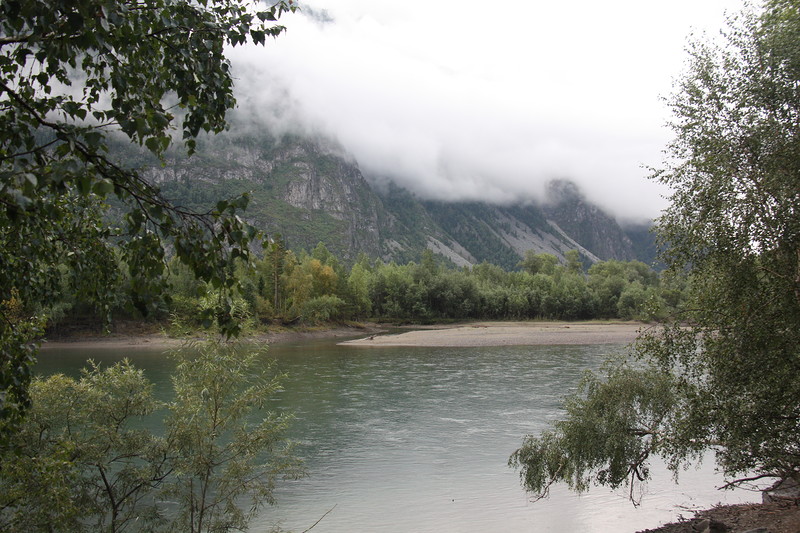
The next village is Koo; if Balykcha is a Turkic name (reminiscent of the city of Balykchi in Kyrgyzstan, the former Rybachye), then Koo is strange name purely in the Altai style.
35. 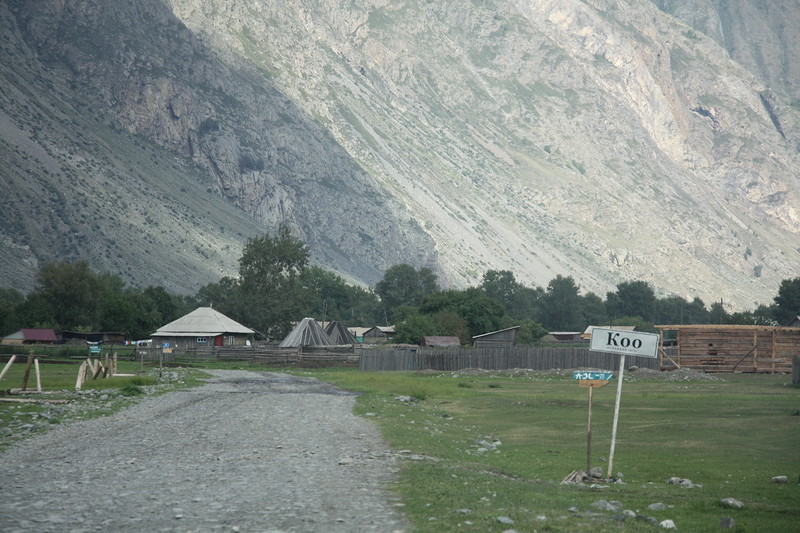
Attention is drawn to the conical shape of the buildings in the courtyards of Altai houses, these are ails - something like wooden Altai yurts. I got the impression that they are much less adapted for movement and travel than the yurts of the steppe nomads.
36. 
If the stationary wooden houses of the Altai both in appearance and in their structure give out their Russian origin, then the ails are living evidence of the former free Altai life which was probably once nomadic. As a rule, villages are now uninhabited, they serve for ceremonial meetings of relatives and all summer leisure outside the home.
Another thing that may seem strange after so many references to the wild disposition of the Altaians is the churches in every large mountain village.
37. 
Yes, through the efforts of the Biysk Altai spiritual mission, a significant part of the Altai peoples in the 19th-20th centuries were baptized, and are officially considered Orthodox believers. However, as is often the case in such distant and culturally alien places, and in general with converts, Christianity is peculiar here. There are many elements of previous beliefs (shamanism); since the beginning of the 20th century Burkhanism, a syncretic teaching with elements of Christianity, Tibetan Buddhism and shamanism, has been spreading in Altai. According to the local Institute of Altaistics, now de facto Burkhanism is the main religion of the Altaians; I lack local awareness to analyze how it fits in with Orthodox church services.
Toward evening, the kind guide Yura took us to the camp site, from which Stone Mushrooms are located about across the river.
38. 
This is one of the few camp sites that have been opened by locals in this area lately - pay your blame for the round house very similar to the village.
For 100 or 200 rubles we agreed to put up our tents on the territory of the camp site - the valley here is narrow, there are few trees, the area is open; as a bonus, we were allowed to wash in the bathhouse.
39. 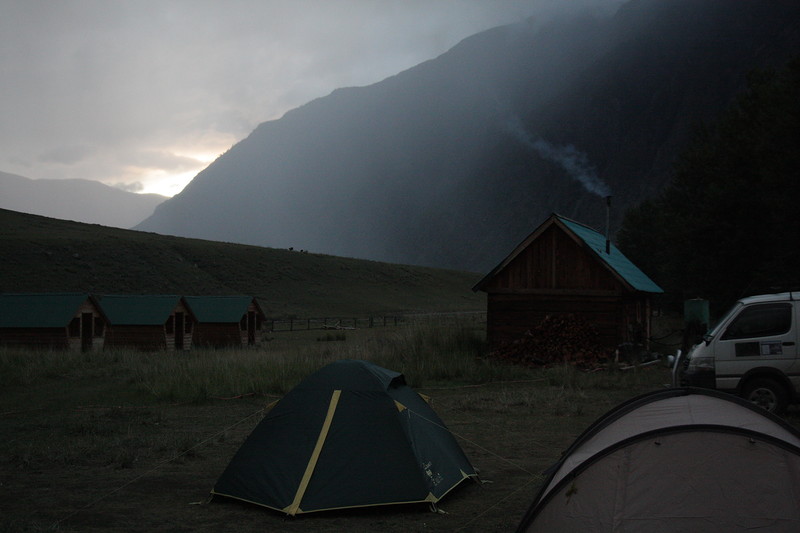
40. 
For 500 rubles on a motorboat we moved to the other side of Chulyshman, to the Akkurum cordon.
41. 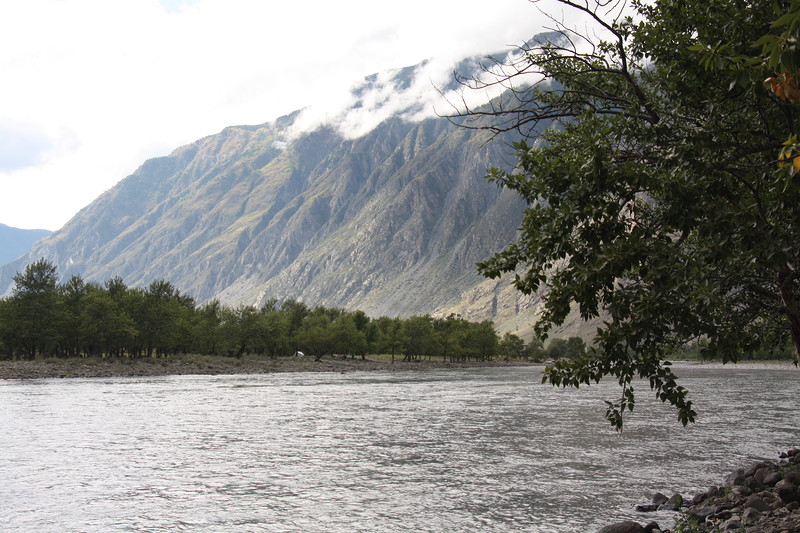
Like on, east coast rivers - this is a biosphere Altai reserve with a fairly strict regime visits. The most interesting local objects are located here - the Uchar waterfall (where we did not get), and the notorious Stone mushrooms. However, you can go to the latter without limitation and collection in favor of the reserve.
The cordon is pastures and the home of a certain Altai family; in the distant and blessed Baltic states, this would be called a "farm".
42. 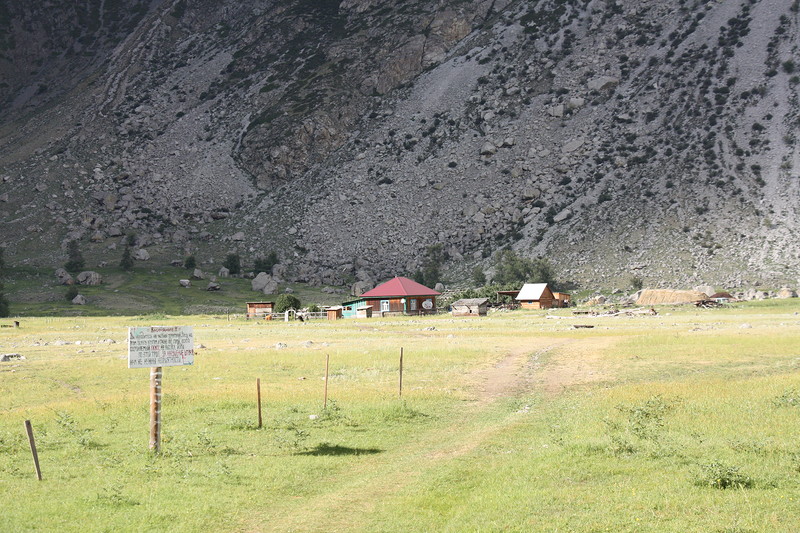
51. 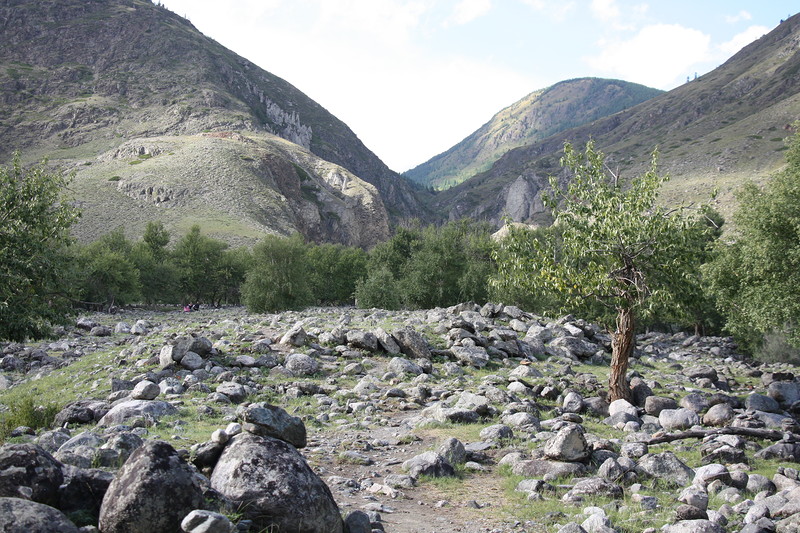
Here are the Mushrooms; close up they have an almost anthropomorphic appearance; like a discordant crowd of some creatures waiting for something.
52. 
53. 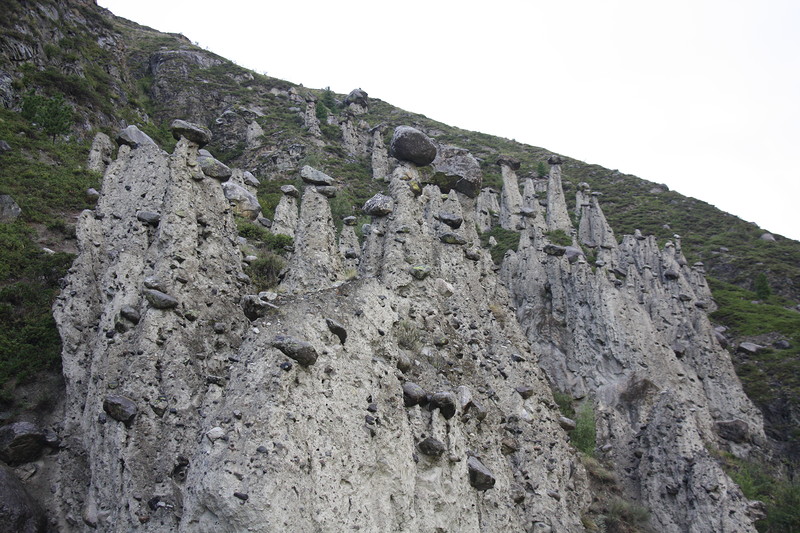
These are remnants - that is, more stable rock mass left after the destruction of the surrounding rock mass. By itself, such a form of relief is not so rare, it seems to be found everywhere where there are mountains and many rocks. Here, for example, are the outliers near the Avsanau pass, Bartuy gorge, Irafsky region of North Ossetia, where I was on a hike back in August 2007:
But more on that in the next episode.
Stone mushrooms are one of the attractions Mountain Altai... They are located between two mountains, so the time for a successful visit is only in the morning about 8-10 hours, the rest of the time they are hidden by the shadow of the mountains. However, it is not easy to get to them - you have to go continuously up the mountain path (although after walking to the Uchar waterfall it is like a highway) to a height of several hundred meters.
Climbing rocks and dust is not very convenient, especially considering that there are simply no horizontal places - all the time upward. From our parking lot, we first buried on a raft to the foot of the mountain, after which we climbed up. They rowed downstream for about a kilometer or a half, but got tired - this is not a walk, the commander is used to rowing one-two-and-some-mother-faster. Thank God, only four hamsters (aka tourists) agreed to go to the mushrooms, so it was easy to row - only seven in a raft. Some tourists did not go because of the wild fatigue after the hike to the Uchar waterfall (located in relative proximity), and the need to get up before 6 in the morning.
We got to the Mushrooms just at 8 am, after 15-20 minutes the sun lit them ... 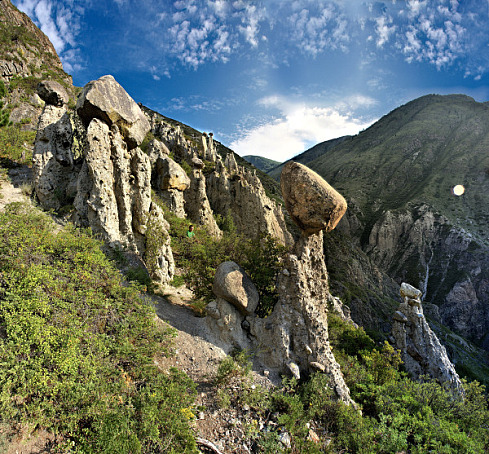
Clicking on the picture opens a larger version in a new window. 
The mushrooms themselves are stones-"caps" left on the "legs" of soft rock, which weathered and washed out over time. 
Valley view. Our camp is located on the terminator on the right side of the river (in fact, on the left bank, since the river flows towards the point of photographing). But you can't see it -ooooooooooooooooooooooooooooooooooooooooooooo! ![]()
This is how the mushroom looks up close. This small one is three meters high. The pebble is clearly a couple of tons ... 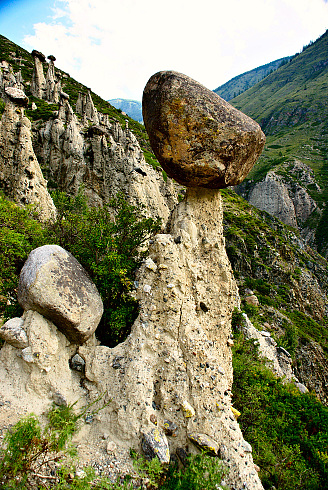
Almost Alice in Wonderland. Only biting off the cap is not easy ...
Again a view of the valley, but it is already clear that we passed above some of the Mushrooms (we did not go around all of them - it is dangerous) 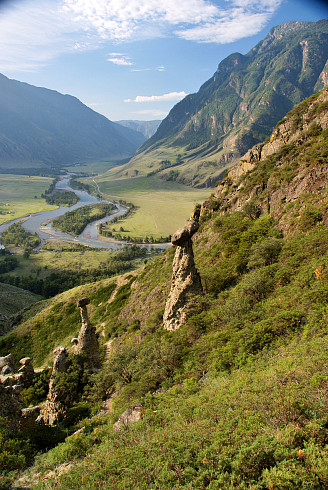
The height of the mushrooms varies from a few meters to a dozen or two. They "grow" directly from the gorge, however, sometimes very close - on a relatively flat part. 
After the earthquake in Altai, several mushrooms fell. In general, scientists tend to believe that our grandchildren will not see them. It's a pity - it's very beautiful. 
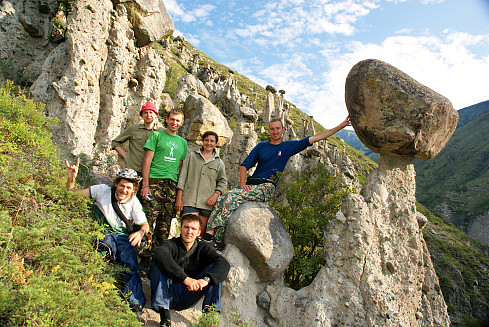
A brave team of sleepy ones. 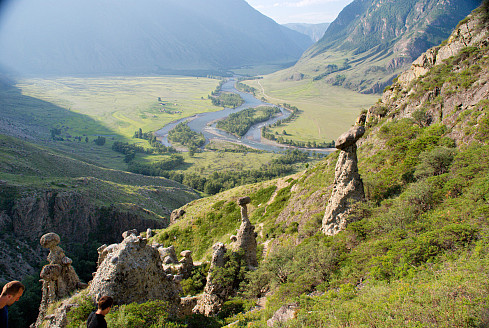
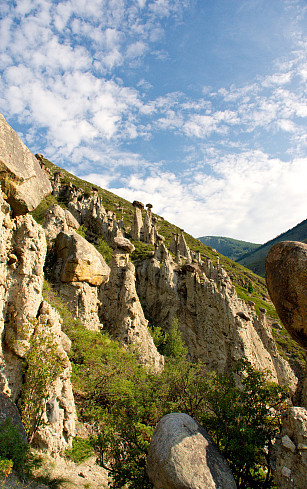
But there are many of them ... 
Mushrooms are different in size, but some can be estimated quite accurately - here you can see a man in a blue T-shirt next to the mushroom (near the center of the frame). 
and here - in green ... 
They grow on the slope of the left mountain. 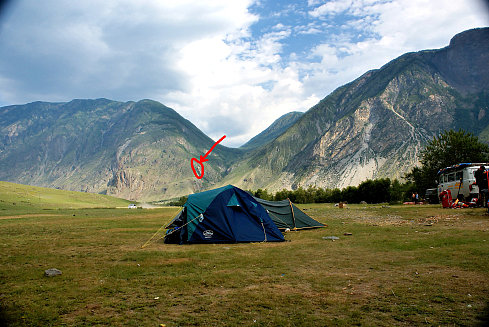
But with a pointer.
Many look at Stonehenge with superstitious delight, while others try to understand where the idols of Easter Island are looking. But few people know that there is an equally mysterious place in Russia. This is the Karasu gorge in Gorny Altai. There is an extraordinary miracle here - stone mushrooms.
Stone mushrooms in Altai are one of the most readily available in Russia. There are also myceliums in the Crimea in the Soter Valley and in the Urals.
Mushrooms in Gorny Altai are located in the Ak-Kurum (or "White talus") tract, on the left bank of the Chulyshman River. Giant hats reach up to 7 meters in height, legs are up to 1.5 meters thick. The diameter of the cap is 2 meters, and its thickness reaches 0.5 meters. There are also small mushrooms. Their height is only 1.5 - 2 meters. But the most amazing thing is that Altai stone mushrooms continue to grow every year! 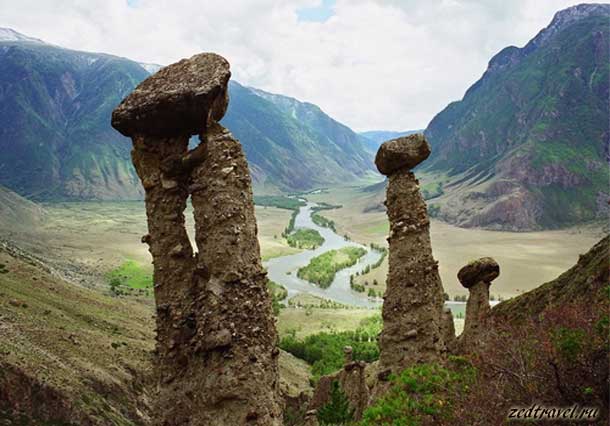
Unfortunately, the life of stone mushrooms is not eternal. They can live for tens, even hundreds of years, but then the merciless impact of water and wind destroys the giants. For example, due to the earthquake in Altai in 2003, several stone mushrooms lost their caps. Now Altai stone mushrooms are gradually sliding down the slope of the Karasu gorge. 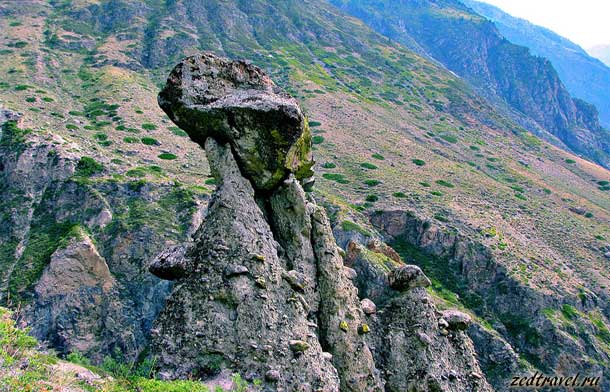
How did such a miracle of nature come about? Even a skilled craftswoman took more than a dozen years for Nature to grow stone mushrooms in Gorny Altai. 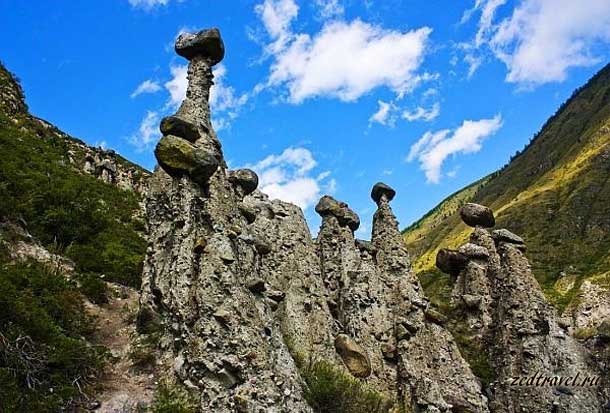
It is the result of selective rock washout or denudation. It all started with mushroom caps. They are formed from solid rocks, i.e. represent a hard block of stone, under which there were softer rocks. Over time, the soft rocks under the caps were washed out without touching the cap. The stem of the mushroom became taller and thinner every year. This is how the 7-meter stone handsome mushrooms arose.

